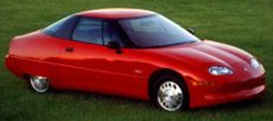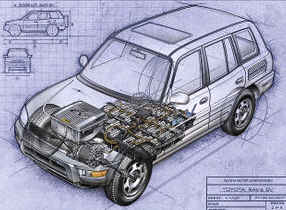Overview
| Electric vehicles have a surprisingly long history. Throughout the years, their role in the market has been heavily influenced by a series of factors, ranging from the price of oil to government regulations, as well as consumer attitudes and product politics of the major vehicle manufacturers. This section gives an overview of the history of EVs from their beginnings until today. |
| Electric vehicles have existed since the mid 19th century | |
| With the advent of combustion engine powered vehicles for personal transport at the beginning of the 20th century, EVs were relegated to niche applications | |
| Between the 70s and 90s, EVs experienced a period of increased demand, due to high petrol prices and environmental regulations (in particular in California); this also lead to a number of EVs produced by major US Vehicle Manufacturers | |
| In the late 90s, low petrol prices lead to a difficult market environment for EVs; almost all EVs produced by major VMs were recalled and destroyed | |
| Today, changing customer attitudes towards the environment and global warming, together with constantly high oil prices, start having an impact on the EV world: an increasing range of models is being offered and purchased | |
| In the future, it is very likely that the focus on EVs will significantly increase, due to increasing performances and decreasing prices of EVs themselves, as well as unbeatable benefits when it comes to protecting the environment |
Electric vehicles have been around for a long time. In fact, they played a major role in transportation before the advent of light and reliable internal combustion engines around the end of the 19th century.
Technically, the first electric vehicle in the sense of a battery electric vehicle was invented in the 1830s by a Scottish businessman. It relied on non rechargeable primary cells. Throughout the rest of the 19th century, EVs gained in importance, thanks in particular to the development of rechargeable lead-based batteries. The UK and France, as well as the US, were at the forefront of EV technology then.
The role of EVs in the market received a significant blow with the introduction of Ford's Model T, an affordable, mass produced car based on an internal combustion engine. Throughout the first half of the 20th century, EVs were continuously confined to special applications, while petrol powered cars became the principal means for personal transport.
In the 60s, and even more so in the 70s, EVs were reconsidered, when some of the disadvantages of depending on foreign oil became apparent during that period. In particular the oil crisis in the 70s lead to an increased consideration of alternative fuels. At that time, two U.S. companies were among the leaders in the EV field: Sebring-Vanguard and ElCar Corporation produced several thousand vehicles.
In the 90s, finally ecological considerations started to play a role next to political / economical ones. The state of California (with the California Air Resource Board or CARB) in particular was at the forefront of ecologically minded regulations with setting minimum quotas for the production of Zero Emission Vehicles (ZEVs) in 1990: by 1998, 2% of cars on California's roads had to be ZEVs. One way for Vehicle Manufacturers to satisfy these quotas was to produce battery-electric vehicles, which they did to some extent. However, the major Vehicle Manufacturers fought this legislation on the grounds of insufficient customer demand (a highly disputed topic), and in 2003 the strict quotas were removed.
Even though ultimately Vehicle Manufacturers were relieved of their obligation to produce EVs, this period yielded a range of interesting developments that gave an indication of the state of the art. In particular two models are worth mentioning:
 |
The EV1 was developed as a purpose-built Electric Vehicle. It was produced from 1996 until 2002 and quickly became the iconic image of electric cars (at least in the US). Over 1100 units were produced, 800 of which were leased to customers for a three year period. The car could be purchased only in California and Arizona ("warm weather states"). |
The 2-seat EV1 achieved ranges of up to 95 miles (on Lead-Acid batteries) and 150 miles (on NiMH batteries) respectively and a top speed of 80 mph (computer regulated). It employed many technologically advanced - and expensive - features (aluminium frame, magnesium frames for seats, magnesium wheels) and achieved a very low drag coefficient (Cd of 0,19). The total leasing cost was around $ 40 K, while GM states that the actual production cost of the vehicle was above $ 80 K. However, GM, as well as other producers benefited from a $ 1,25 bn Government programme for the development of a new generation of vehicles.
After the removal of the ZEV regulation, and the end of the 3-year leases, virtually all EV1s were recalled from the market and destroyed. The EV1 was the only purpose built electric vehicle ever to be released by a major vehicle manufacturer. Its destruction is surrounded by a lot of controversy.
GM argues that consumer demand was limited and the vehicle could not be sold at a competitive price. Furthermore, problems with the battery packs (in particular costs and heat issues) and issues with guaranteeing the vehicle's maintenance were cited. On the other hand, consumer groups are of the opinion that "Big Oil" played a major role in this consideration and that there was in fact significant demand for this kind of vehicle in the market. This topic was subsequently brought to a wide public in the film "Who killed the electric car", released in summer 2006.
 |
The Toyota RAV 4 gives an indication of what was possible by using an existing platform (RAV 4), and converting it to an all-electric vehicle. It was produced in more than 1200 units between
1997–2002, many of which leased to fleet operators. Its cost was around $ 40 K (without subsidies).
The RAV4 EV was equipped with 24 12V NiMH batteries. |
Unfortunately, the RAV 4 had a similar fate to the EV1. Most vehicles were recalled and subsequently crushed, but eventually Toyota succumbed to the public "don't crush" demand and a few vehicles are still available in the market today (in the US).
As of early 2007, there is an increasing range of purpose built, light and practical electric vehicles. Some of these EVs have been around for a several years, and many more will become available during the course of 2007.
Looking at the ranges and top speeds of compact EVs available today, it might appear that EVs have not advanced much over the course of the last decades. This is mainly due to the battery technology which is basically the same as 100 years ago in the case of Lead based batteries. However, in recent years significant advances have been made on this front, in particular in the form of Li-Ion batteries. Currently, these are still relatively expensive, but they are increasingly becoming available even to compact EVs.
Considering the major Vehicle Manufacturers, there are currently no concrete plans for the production of a battery-electric vehicle. recently, and after the success of Toyota's Prius, most VMs seem to have jumped on the Hybrid-Electric Vehicle bandwagon, which they hope will have a positive impact on their public image (and possibly sales).
At the same time, conversion efforts, often carried out by small specialized firms or individuals, show what is possible today. Price is still a major deterrent in this case, due to the cost of components and work involved. Also in this case, though, prices will decrease with an increase in production.
For more detail on EVs available today (electric cars, scooters, bikes) please see the specific sections of this website.
